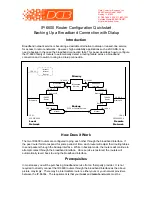
Data Comm for Business, Inc.
2949 County Road 1000 E
Dewey, IL 61840
217-897-6600, FAX 217-897-1331
Outside Illinois: 800-4DCBNET
http://www.dcbnet.com
routable through the broadband network. In other words, the provider must be providing you with
routing to
your subnets. If they are providing you with a single IP address at each site, it will not work in this
application.
Setting up the Routers
We are going to step through configuration of a pair of routers as shown in the above network
diagram. Your actual configuration will vary, but the key point is to understand the relationship
between the interface addresses and the entries in the routing tables. I will try to point these out
as we go along.
Before starting, reset both routers to their default configuration. This can be done from the Serial
Setup or from the Administration web page.
Local IP-6600
1. Ethernet-A IP Configuration
– Set the IP address and Subnet Mask for your local network.
In our example, this would be IP: 10.0.1.2, Subnet Mask: 255.255.255.0. This network must
be routable across the broadband connection. If you are purchasing service from a third-
party provider, this network must be arranged with them.
2. Tools/ISP-Failover
- Enable failover and select the ping method. Set Ethernet-B as the
primary interface and Serial-B as the failover interface. Set both the Failover-Time and
Recovery-Time to 60 seconds. Set the Ping Target to the IP address of the remote IP-6600’s
Ethernet-B interface. In our example, this would be 10.230.0.13. Finally, disable the Block
Default Route field.
3. Ethernet-A Static Routes (Optional)
– Set a default routing entry for your Intranet router. In
our example this would be an entry of Target: 0.0.0.0, Netmask: 0.0.0.0, Gateway: 10.0.1.1,
Failover: No.
Note: You will also need to add a route to your Intranet router for the remote
subnet. We can’t give specifics on how to do this, but essentially you need to add a routing
entry for Target 10.0.2.0, Netmask: 255.255.255.0, Gateway 10.0.1.2.
4. Ethernet-B IP Configuration
– Set the IP address and Subnet Mask for your broadband
connection. In our example, this would be IP: 10.225.0.7, Subnet Mask: 255.255.255.0. If
you are purchasing service from a third-party provider, these fields will be assigned by them.
5. Ethernet-B Static Routes
– Set a route to the remote subnet through the broadband router.
For our example, this would be an entry of Target: 10.0.2.0, Netmask: 255.255.255.0,
Gateway: 10.225.0.1, Failover: Yes. Notice that this is a failover route. A similar route will
also be placed in the Serial-B Static Routes (step 9).
6. Ethernet-B Static Routes
– Set a host route to the remote IP-6600’s Ethernet-B interface.
For our example, this would be an entry of Target: 10.230.0.13, Netmask: 255.255.255.255,
Gateway: 10.225.0.1, Failover: No. This routing entry causes the ping requests, used for
failure detection, to go through the broadband connection.
7. Serial-B Operating Mode
– Set the port mode to Disabled and set the line parameters
appropriate for your modem. The IP-6600 will automatically enable the port when a failure
occures.







